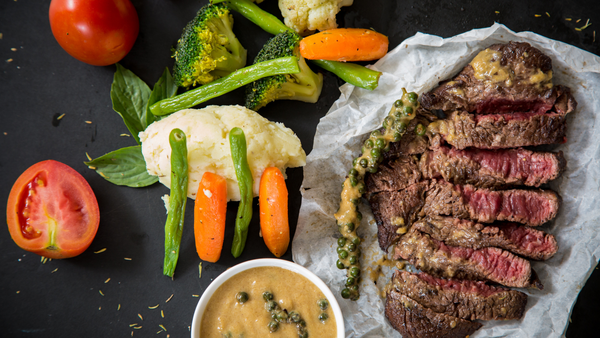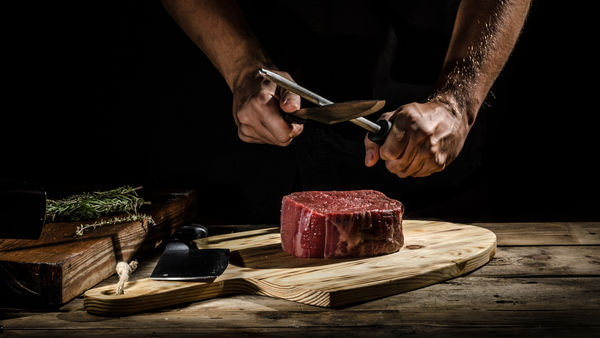
Written by Justin Harris and Team 1D
Ketosis is a metabolic state in which the body burns stored fat for energy instead of carbohydrates. This process can be achieved through a low-carbohydrate, high-fat diet, also known as the ketogenic diet.
People with all different fitness goals have turned to the ketogenic diet for various reasons, including weight loss, improved athletic performance, better mental clarity, and management of certain health conditions such as epilepsy and type 2 diabetes.
The ketogenic diet's popularity has grown exponentially as more and more people share their success stories on social media. But is it right for bodybuilders?
We'll break down this question from one of our clients.
Client question: Is the keto diet optimal for fat cutting?
So I had some stuff to finish up at my house that I tried to use for [carb] sources and obviously my numbers aren't dialing in perfect because of it but I am having kind of a hard time figuring out what to use for this intra and post-workout carb source if I'm trying to be in keto.
My understanding of being in keto would mean that the fat burning would be a bit easier since weight falls off when you're in keto with the right calories.
Keto diet vs. Caloric deficit
If you're already reducing your calorie intake, being in ketosis may not necessarily provide any additional benefits. When you're in a 500-calorie deficit on the keto diet, your body will burn 500 calories of stored energy, primarily from fat, with some use of ketones for energy.
If you're not in ketosis and you're also in a 500-calorie daily deficit, your body will also burn 500 calories from stored energy, primarily from fat, but will use glycogen for energy instead of ketones. The main difference between the two is the source of energy, ketones versus glucose.
What exactly are Ketones and Glucose?
Even though ketones and glucose are not exactly the same things, they both provide energy for the body. Glucose is a type of sugar that is the primary source of energy for the body's cells. However, if glucose is not available in sufficient amounts, the liver can break down stored glycogen to produce glucose for energy.
Similarly, when the body is in a state of low carbohydrate intake, the liver can break down stored fat to produce ketones, which can serve as an alternative energy source for the body's cells.
While glucose and ketones are different energy sources, they both play important roles in providing energy to the body.
Glucose is easier to get from external sources, but ketones are more energy dense (which actually isn't good on a diet) but may be more effective as a fuel for the brain.
Some studies show that ketone-fueled brains are more efficient. This would make sense as our bodies evolved to only have two nutrients required for survival: essential amino acids and essential fatty acids.
Both of these are found in all animal-based meat, and both of which are not found in a single source of nearly all non-animal-based food sources.
Ketones vs. Glucose: who wins?
Ketones and glucose are both forms of energy that are easy for the body to convert.
For example, 100g of glucose gives about 8kg of ATP (energy), and 100g of ketones gives about 9-10kg of ATP (energy).
So even though ketones are actually a more efficient energy source, that's the opposite of what you want in a diet. You want to be able to eat the most amount of food for the lowest amount of energy.
However, it's close enough that it's unlikely you'd ever see a difference in a contest over the length of either diet.
Some of the benefits of the ketogenic diet
There are many benefits to a ketogenic diet. Since your body burns stored fat instead of carbs while in ketosis and fats tend to keep you satiated longer, you won't feel as hungry. Additionally, ketosis will keep your insulin levels down, having the same satiation effect.
Additionally, with keto, you can avoid the surge of insulin in response to the carbohydrate-rich meal can lead to increased uptake of amino acids in muscle cells.
Insulin is a hormone that can act as a mild CNS depressant, which means that it can decrease activity in certain parts of the brain and promote relaxation. This is why after a big carbohydrate meal, when insulin levels are high, you feel sluggish.
The ketogenic diet, also known as the keto diet, is a low-carbohydrate, high-fat diet that has been studied for its potential benefits beyond weight loss. Some of the potential benefits of the keto diet are:
- Improved Blood Sugar: People with type 2 diabetes and those who are at risk of developing it may have better control. By reducing carbohydrate intake, the body produces less insulin, which can help regulate blood sugar levels.
- Reduced Inflammation: The keto diet has been shown to have anti-inflammatory effects on the body. This may be due to the reduction in sugar and refined carbohydrates, which can contribute to inflammation.
- Improved Cognitive Function: The keto diet may improve cognitive function, including memory and focus, in some people. This may be due to the increased production of ketones, which are an alternative fuel source for the brain.
- Reduced Risk of Heart Disease: The keto diet may help reduce the risk of heart disease by improving cholesterol levels. Studies have shown that the diet can reduce triglyceride levels and increase levels of "good" HDL cholesterol.
- Potential Treatment for Epilepsy: The keto diet has been used for decades as a treatment for epilepsy, particularly in children who do not respond to medication. The diet has been shown to reduce the frequency and severity of seizures in some people.
Getting into Ketosis
To achieve ketosis, you have to restrict carb intake and increase the intake of healthy fats and moderate amounts of protein. Here are the general steps to get into ketosis:
- Reduce Carbohydrate Intake: Limiting carbohydrate intake to 20-50 grams per day is usually necessary to achieve and maintain ketosis. This means avoiding high-carbohydrate foods such as grains, sugar, fruits, and starchy vegetables.
- Increase Fat Intake: Increasing the intake of healthy fats such as olive oil, coconut oil, avocado, nuts, and seeds is essential to providing the body with the necessary fuel for ketosis.
- Moderate Protein Intake: Consuming moderate amounts of protein is important to prevent muscle loss and promote satiety. Generally, protein intake should be around 0.6-1 gram per pound of body weight. More on this later.
- Stay Hydrated: Drinking plenty of water is essential to maintain proper hydration and support metabolic processes in the body.
- Be Patient: It can take several days to a few weeks for the body to enter ketosis, and during this time, some people may experience symptoms such as fatigue, headaches, and cravings. These symptoms usually subside after a few days as the body adapts to using fat as the primary fuel source.
Protein and Keto: Let's get real.
Protein can kick you out of ketosis almost as easily as carbs.
If you add it up, the keto diet has you at 100g of protein per day. There is about 500g in a pound, so every 5 days, you're eating a pound of protein as far as the amino acid weight is concerned.
About 30g is needed for the repair of damaged protein structures, so 70g of the 100g is additional to this and able to synthesize new muscle, so 100g of protein intake per day adds up to about 490g of protein allowed for protein synthesis per week, which is almost exactly one pound of protein structures.
If you were using all 490g of that to build new protein structures, you'd be gaining 1 pound of muscle per week or over 50 lbs per year. Since that isn't the case, any number under that amount is being used as something other than protein.
The First Step
The first step is to convert those amino acids to glucose through gluconeogenesis.
This takes some energy (which is why protein is advantageous in a diet). Around 10-15% of the total protein calories.
This is now glucose in the body, and if it's enough glucose, it will kick you out of ketosis. This is why protein needs to be only about 20-30% of the total calorie count to keep you in ketosis.
That glucose is then either used as energy or is further converted through Acetyl CoA and the fatty acid synthesis pathway into a fatty acid. This takes another 5-15% of the total energy of the protein in the conversion process.
So if you're currently eating 115g of protein, then you're getting about 85g of protein after the maximum amount needed to repair damaged protein structures in the body.
The most you can convert to muscle over the long term from that is about 25g per day. Which would be over 20 lbs of new protein structures (muscle) per year.
So even if you convert 25g per day (no one is gaining 20 lbs of muscle per year, though), then that's 60g of protein per day that will be going through gluconeogenesis to become a carbohydrate.
So that's 60g carbs per day.
How to stay in ketosis when loading up on protein
My diet has you at 100-105g per day. At 100g, there's 70g after the maximum amount needed to repair damaged structures. If you remove the 25g we removed above for protein synthesis, that leaves 50g protein per day that will be going through gluconeogenesis.
So, we have an extra 10g of glucose per day to play with.
Since you're not having workout carbs on low days, and assuming you're training with weights 5x per week, we have 5 days per week with extra workout carbs. I have you at 46g carbs (which we can lower if it looks like it's taking you out of ketosis....and either way, we'll be removing them as the diet goes on anyway, and we need to reduce calories). At 5x per week, that's 230g carbs.
So, without the workout carbs, you had in the macros you gave me, you have 60g of glucose per day from protein sources. Over a 7-day week, that's 420 total grams of glucose from protein.
With my macros and the workout carbs, you have the 230 workout grams plus 250g carbs from the 50g glucose from protein sources. That's 480g total grams of glucose per week.
So the difference between the two approaches is 60g of glucose per week or 8.5g extra per day. I didn't think that would be enough to change whether or not you stayed in ketosis.
It may. We won't know until you check. But if it is, we just lower it a few grams (which we will as the diet goes on regardless)
The "5g" listed in the other meals is really just a placeholder. I used to just write "vegetables" there in the old way I did diet plans, but now I have an algorithm that outputs numbers across the other pages, so I put 5g there as a vegetable placeholder.
The total carb amount is approximately zero as things like "107g broccoli" won't have more than maybe a gram of actual insulin-impacting carbohydrates.
Other things to consider: The Ketogenic Diet isn't for everyone.
It's important to note that the process of getting into ketosis will likely be different for everyone and may not be for everyone.
People with certain health conditions, such as diabetes or liver disease, should not attempt to go keto without first consulting with a healthcare professional. Some long and short-term side effects include:
- Keto Flu: During the initial stages of the keto diet, some people may experience flu-like symptoms such as headaches, fatigue, nausea, and constipation. This is often referred to as the "keto flu" and is thought to be caused by the body's adjustment to a low-carb diet.
- Digestive Issues: The keto diet is low in fiber, which can cause constipation and other digestive issues. Additionally, high fat intake can cause gastrointestinal distress in some people.
- Electrolyte Imbalances: When following a low-carbohydrate diet, the body may excrete more electrolytes such as sodium, potassium, and magnesium. This can lead to imbalances in these minerals, which can cause symptoms such as muscle cramps, weakness, and fatigue.
- Increased Cholesterol Levels: While the keto diet can improve cholesterol levels for some people, it can also increase cholesterol levels in others, particularly in those with a family history of high cholesterol.
- Kidney Stones: The keto diet can increase the risk of developing kidney stones due to the high intake of animal protein and low intake of fluids.
The Wrap-Up
In conclusion, the ketogenic diet is very popular among people with different fitness goals, including bodybuilders. While being in a caloric deficit on the keto diet can lead to fat loss, the main difference between the keto diet and a regular caloric-restrictive diet is the source of energy, ketones versus glucose.
The benefits of the keto diet include improved blood sugar control, reduced inflammation, improved cognitive function, reduced risk of heart disease, and potential treatment for epilepsy.
However, bodybuilders should carefully consider their dietary needs and goals before committing to a keto diet, as it may not be optimal for everyone.
Ultimately, the keto diet can be an effective tool for bodybuilders as long as it is approached in a thoughtful and informed manner.

Both the ketogenic diet and a calorie deficit can be effective for bodybuilders trying to cut. However, the choice between the two will depend on the individual's goals, preferences, and body composition.
However, the ketogenic diet may not be suitable for everyone, as it can be challenging to maintain and can cause side effects such as fatigue, brain fog, and digestive issues.
On the other hand, a calorie deficit simply means consuming fewer calories than your body burns, which can also lead to weight loss and body fat reduction. This approach can be easier to maintain than the ketogenic diet and may be more suitable for those who prefer a balanced macronutrient intake.
However, it's important to ensure that the calorie deficit is not too extreme, as this can lead to muscle loss and a slower metabolism.
Ultimately, the best approach for bodybuilders trying to cut will depend on their individual needs and preferences. It may be helpful to consult with a registered dietitian or a certified personal trainer to develop a personalized plan.










